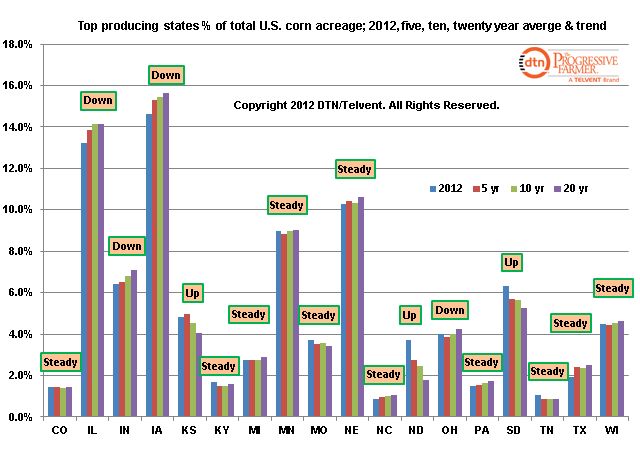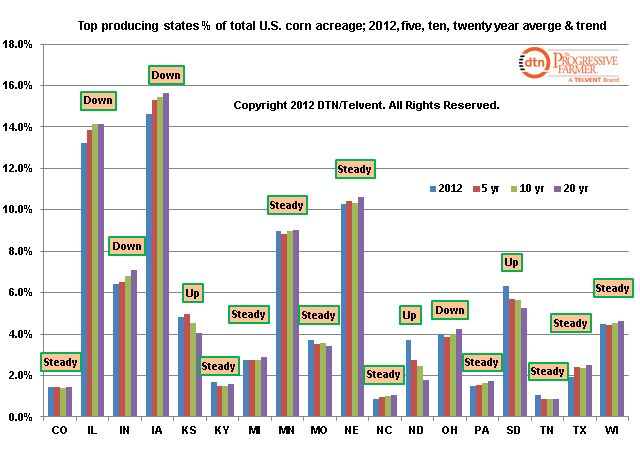Fundamentally Speaking
Trends for U.S. Corn Acreage in Top States
Earlier this week, the consulting firm Informa estimated 2013 U.S. corn planted acreage at 99.0 million acres.
This continues to the trend of farmers devoting increasing amounts of their total planted area to corn, the number one commodity crop in the country with acreage now projected at the highest since 1936.
Of increasing interest to the trade is where this acreage expansion is occurring for this has important implications for production given different yield trends in various states and trade flows given disparate regional demand.
P[L1] D[0x0] M[300x250] OOP[F] ADUNIT[] T[]
This graphic shows the percent of the total U.S. corn acreage contributed by each of the top 18 producing states for 2012, the five, ten, and 20 year average along with any trend were able to discern looking the numbers.
As we have discussed in prior pieces, it is quite evident that there has been a shift over the years with U.S. corn acreage moving from the eastern and southern sections of the country to more northern and western states.
Iowa and Illinois remain the two largest corn producing states in the country but their proportion of U.S. planted area has declined over the years.
The same can be said of Ohio and Indiana, two other large Eastern Corn Belt that have also seen their percent of U.S. corn planted are decline.
On the other hand, substantial increases in corn planted acreage have been seen in regions of the Plains especially in the North Dakota along with Kansas and South Dakota.
We note that most other states have seen corn acreage stay steady especially in the more northern states of MI, WI, and MN.
Reasons for this acreage increase include higher returns for corn in some of the western states that used to seed various types of wheat and sorghum and increasing usage in the western U.S. from both beef and dairy operations.
In recent years, we note that the more northern states have been less subjected to summer weather extremes such as high temperatures and limited rainfall.
Earlier this week the consulting firm Informa estimated 2013 U.S. corn planted acreage at 99.0 million acres. This continues to the trend of farmers devoting increasing amounts of their total planted area to corn, the number one commodity crop in the country with acreage now projected at the highest since 1936. Of increasing interest to the trade is where this acreage expansion is occurring for this has important implications for production given different yield trends in various states and trade flows given disparate regional demand. This graphic shows the percent of the total U.S. corn acreage contributed by each of the top 18 producing states for 2012, the five, ten, and 20 year average along with any trend were able to discern looking the numbers. As we have discussed in prior pieces, it is quite evident that there has been a shift over the years with U.S. corn acreage moving from the eastern and southern sections of the country to more northern and western states. Iowa and Illinois remain the two largest corn producing states in the country but their proportion of U.S. planted area has declined over the years. The same can be said of Ohio and Indiana, two other large Eastern Corn Belt that have also seen their percent of U.S. corn planted are decline. On the other hand, substantial increases in corn planted acreage have been seen in regions of the Plains especially in the North Dakota along with Kansas and South Dakota. We note that most other states have seen corn acreage stay steady especially in the more northern states of MI, WI, and MN. Reasons for this acreage increase include higher returns for corn in some of the western states that used to seed various types of wheat and sorghum and increasing usage in the western U.S. from both beef and dairy operations. In recent years, we note that the more northern states have been less subjected to summer weather extremes such as high temperatures and limited rainfall.
Joel Karlin, Western Milling
(KA)






Comments
To comment, please Log In or Join our Community .